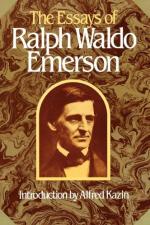[Footnote 557: Lydgate. John Lydgate was an English poet who lived a generation later than Chaucer; in his Troy Book and other poems he probably borrowed from the sources used by Chaucer; he called himself “Chaucer’s disciple.”]
[Footnote 558: Caxton. William Caxton, the English author, more famous as the first English printer, was not born until after Chaucer’s death. The work from which Emerson supposes the poet to have borrowed Caxton’s translation of Recueil des Histoires de Troye, the first printed English book, appeared about 1474.]
[Footnote 559: Guido di Colonna. A Sicilian poet and historian of the thirteenth century. Chaucer in his House of Fame placed in his vision “on a pillar higher than the rest, Homer and Livy, Dares the Phrygian, Guido Colonna, Geoffrey of Monmouth, and the other historians of the war of Troy.”]
[Footnote 560: Dares Phrygius. A Latin account of the fall of Troy, written about the fifth century, which pretends to be a translation of a lost work on the fall of Troy by Dares, a Trojan priest mentioned in Homer’s Iliad.]
[Footnote 561: Ovid. A Roman poet who lived about the time of Christ, whose best-known work is the Metamorphoses, founded on classical legends.]
[Footnote 562: Statius. A Roman poet of the first century after Christ.]
[Footnote 563: Petrarch. An Italian poet of the fourteenth century.]
[Footnote 564: Boccaccio. An Italian novelist and poet of the fourteenth century. See note on “Italian tales,” 539. It is supposed that the plan of the Decameron suggested the similar but far superior plan of Chaucer’s Canterbury Tales.]
[Footnote 565: Provencal poets. The poets of Provence, a province of the southeastern part of France. In the Middle Ages it was celebrated for its lyric poets, called troubadours.]
[Footnote 566: Romaunt of the Rose, etc. Chaucer’s Romaunt of the Rose, written during the period of French influence, is an incomplete and abbreviated translation of a French poem of the thirteenth century, Roman de la Rose, the first part of which was written by William of Loris and the latter by John of Meung, or Jean de Meung.]
[Footnote 567: Troilus and Creseide, etc. Chaucer ascribes the Italian poem which he followed in his Troilus and Creseide to an unknown “Lollius of Urbino”; the source of the poem, however, is Il Filostrato, by Boccaccio, the Italian poet already mentioned. Chaucer’s poem is far more than a translation; more than half is entirely original, and it is a powerful poem, showing profound knowledge of the Italian poets, whose influence with him superseded the French poets.]
[Footnote 568: The Cock and the Fox. The Nun’s Priest’s Tale in the Canterbury Tales was an original treatment of the Roman de Renart, of Marie of France, a French poet of the twelfth century.]




